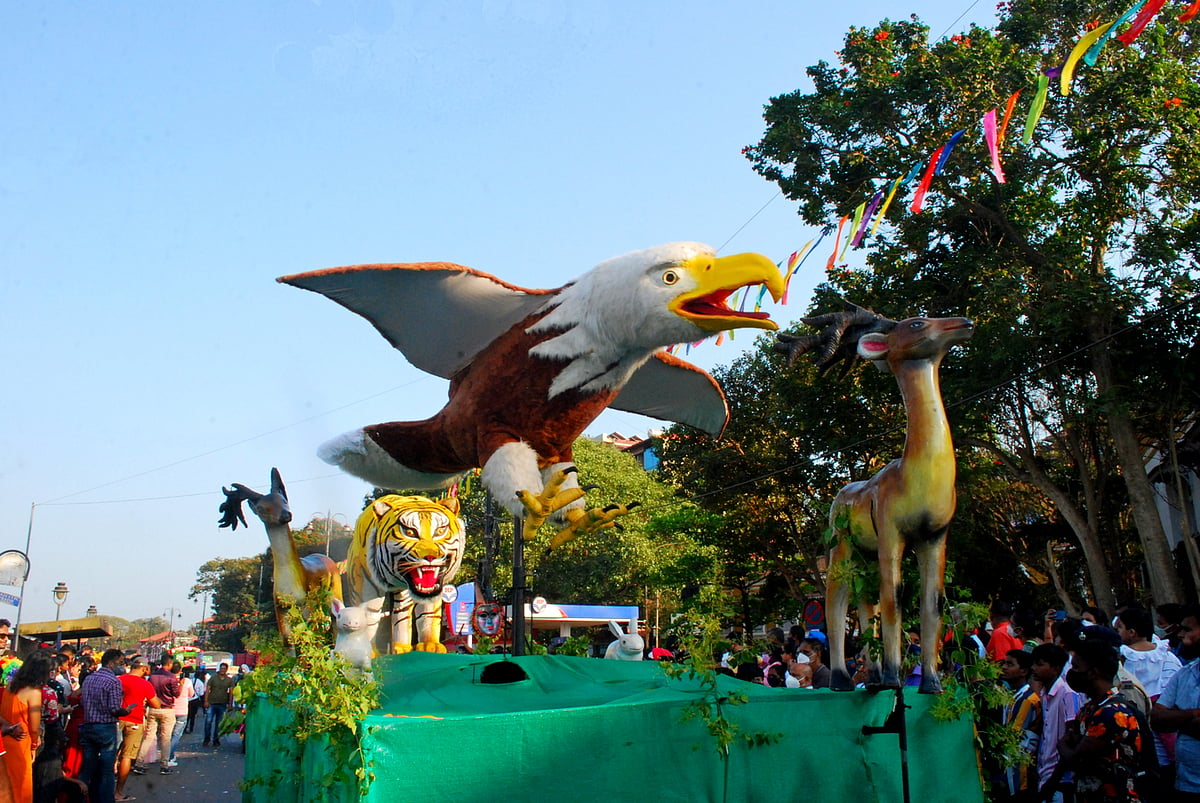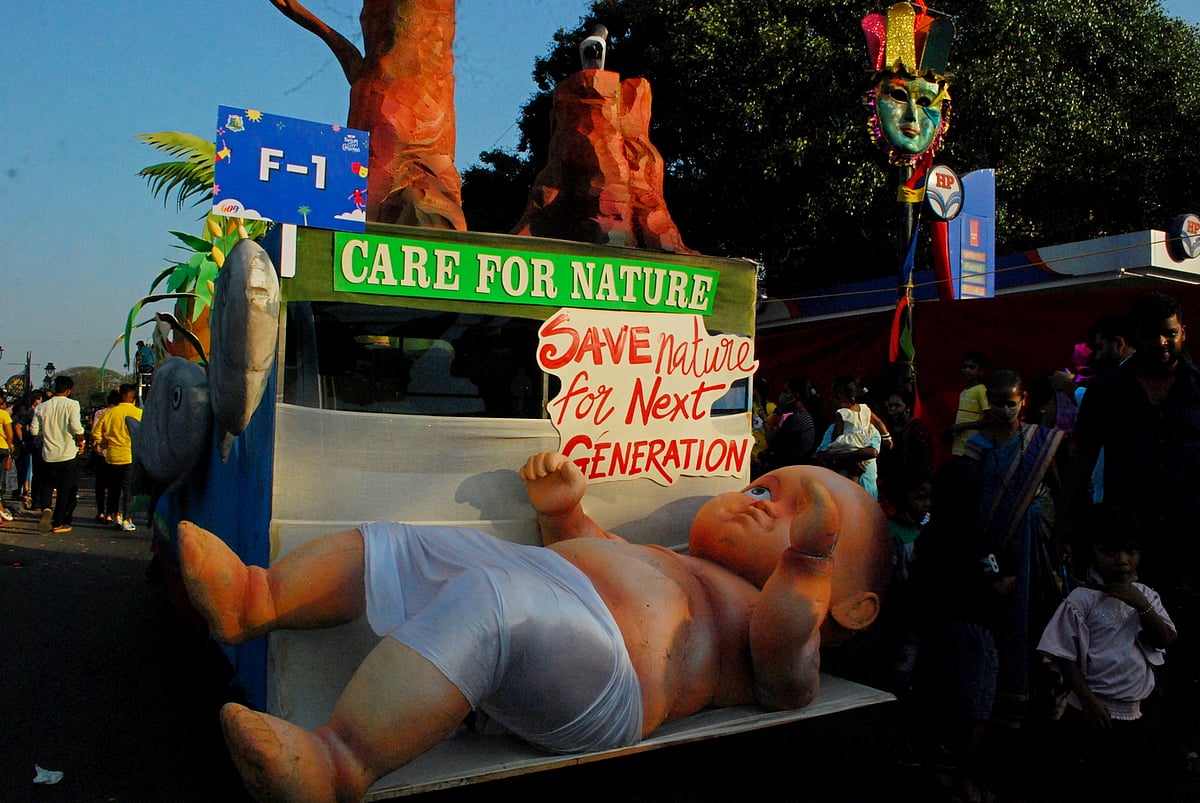Goa Carnival 2022: It was fun but it was not quite the same!
“Truly disappointing fare; quality of the floats barring a few has declined. The feeling of joie de vivre is getting lost each passing year,” says Armando Gonsalves, engaged in promoting the Carnival

The crowd had begun to gather around the Adil Shah Palace, which was once the State Secretariat and is today Panaji’s oldest building. The long wait for the four-day Carnival was about to end as people, dressed for the occasion, waited for the parade to pass after which they had a choice of venues for an evening of fun, food, dance and music.
It always kicks off on a Saturday, the gateway to the weekend. A little after 4 p.m., the float parade began to roll from the new Patto bridge area. King Momo had made the official proclamation of his reign with Emiliano P Dias, King Momo of 2022, urging people to 'eat, drink and make merry, responsibly!'
Old-timers remember the Carnival as an event for family time and fun. Maria Lourdes Bravo da Costa e Rodrigues, author of ‘Feats, Fragrances, and Observances of Goa,’ recalls, “Goa's celebration of this festival goes back to the early 1900s, if not earlier. It's now becoming bigger and louder with each passing year.”
With hotels and resorts hosting and promoting their own evenings of fun and frolic, the Carnival is now more commercial. But some of the floats did flag local tradition. One particular float stood apart from the rest. This was the tableau of the Khajekars.
Finger sticks dipped in ginger-jaggery or sugar syrup and coated with sesame seeds to make it tasty is known as the Goan khaje or kadio-bodio. Making kadio-bodio continues to be a traditional vocation of many khajekar families in Goa belonging to both Hindu and Christian families. The sweet is ubiquitous on all festive occasions. Besides kadio-bodio, other Goan favourites like Goan pork chourico or sausage bread, kharrem or dry fish, and biyyo or cashew seeds were also part of the parade.
The parade, which rolled out from the Mandovi bridge and culminated at the Kala included the Kunbi folk dances portraying social themes, Corridinho, a form of Portuguese folk dance, Konkani songs, traditional dances and music.
Other floats showcased traditional occupations like padekars or coconut pluckers, nustekars or fisherfolk, cane weavers, potters, and feni distillers. Through the music and dance, there were also floats putting out important social messaging on issues like afforestation, environmental conservation and COVID.



Popular chef Vasquito Alvares once again was at the heart of the food festival at the Samba Square in the state capital. His grandfather, late Vasco Alvares, was Chief Officer of Panjim Municipality and involved in organizing the Carnival during Portuguese rule. Known as Chef Vasco after his grandfather with whom he shares a birthday, Alvares has seen the Carnival change over time.
“With the State backing it, the Carnival has now become theme-based. It was earlier just four days of fun. Carnival is essentially carnage or meat. It is a festival of colour like Holi, celebrated just before the month of Lent observed religiously by most Catholics in Goa.
Joaquim Teles agrees. Creativity and life need to be put back into the festivities, says the former president of the Panjim Carnival Committee. While the celebration comprises the parade and the the Samba Square festival at the municipality’s Garcia de Orta Garden, “traditional floats are not participating as much as they used to,” he says.
Armando Gonsalves, engaged in promoting the Carnival and Jazz in Goa, is also forthright. “Truly disappointing fare; quality of the floats barring a few has declined. The feeling of joie de vivre is getting lost each passing year.”
Writer Manan Dhuldhoya, who spends time between Mumbai and Goa, however had a different take. He enjoyed the food and Feni cocktails specially created for the Carnival on day two, he recalls with satisfaction. At the Samba Square, there were not too many tourists though, he says. People were greeting each other, they knew each other and were clearly local residents. He had missed live music since the U2 concert of 2019 in Mumbai, and enjoyed every bit of the live music at the carnival.
Not everyone was as lucky as Dhuldoya and his friends. On the first of the four-day celebrations, a huge crowd prevented Jerome Araujo and family from spending quality time listening to popular Konkani singer Lorna Cordeiro, known as Goa’s nightingale.
Lorna enthralled people with her power-packed performance as she belted out classics like Aikat mazo tavlo", "Nachomia Kumpasar", "Pisso”, “Bebdo", "Red Rose", "Lisboa", "Adeus”, and “Tuzo Mog." “We were looking forward to her performing live but the crowd came in the way and we soon headed out for a family dinner at a nearby restaurant,” recalls a disappointed Araujo.
Tony Dias, President of Clube Nacional, a prestigious club of Panjim, blames the youth. “Youngsters can give wings to the Carnival. He recalls his childhood when his father would take him on a bullock cart, with his uncle playing the guitar and his dad the violin. “All of us children followed the procession. It was enchanting. We now get professionals involved. We get sponsorships because for the parade, we need floats and floats cost money,” he says.
Dias believes there must be a revival of the Khell Tiatr, a very popular form of drama in South Goa. During the Carnival, each Goan village hosts its own unique show. This year the organisers added the Alvorada or the brass band, played at the crack of dawn of any feast in Goa.
“More the youngsters get involved with sponsors and the government, the more attractive the Carnival is going to get. Viva Carnival! Viva Goa!” he gushes.
(This article was first published in National Herald on Sunday.)
Follow us on: Facebook, Twitter, Google News, Instagram
Join our official telegram channel (@nationalherald) and stay updated with the latest headlines
